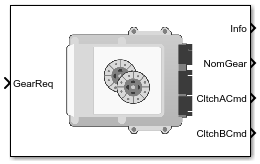DCT Controller
Dual clutch transmission controller

Libraries:
Powertrain Blockset /
Transmission /
Transmission Controllers
Description
The DCT Controller block implements a dual clutch transmission (DCT) controller. You can specify the clutch open, close, and synchronization timing parameters. The block determines the clutch commands using integrator-based timers and latching logic that is based on the specified timing parameters and gear request.
Examples
Build Conventional Vehicle Model
Build a vehicle with an internal combustion engine using the conventional vehicle reference application.
Ports
Inputs
Gear number request, Greq.
Output
Bus signal containing these block calculations.
| Signal | Description | Variable |
|---|---|---|
GearReq | Gear number request | Greq |
GearEngd | Nominal gear commanded by the controller | Go |
GearEffct | Effective gear | NA |
CltchACmd | Clutch pressure command for odd-numbered gears, between | NA |
CltchBCmd | Clutch pressure command for even-numbered gears, between | NA |
Nominal gear for shifting. The Dual Clutch Transmission block uses this signal for the smooth application of inertial, efficiency, gear ratio, and damping parameters.
Clutch pressure command for odd-numbered gears, between
0 and 1.
Clutch pressure command for even-numbered gears, between
0 and 1.
Parameters
Time required to engage and disengage the clutch during shift events, tc, in s.
Programmatic Use
To set the block parameter value programmatically, use
the set_param function.
To get the block parameter value
programmatically, use the get_param function.
| Parameter: | tc |
| Values: | .1 (default) | scalar |
| Data Types: | double |
Time required for gear selection and synchronization, ts, in s.
Programmatic Use
To set the block parameter value programmatically, use
the set_param function.
To get the block parameter value
programmatically, use the get_param function.
| Parameter: | ts |
| Values: | .01 (default) | scalar |
| Data Types: | double |
Selecting this parameter initially locks the clutch.
Programmatic Use
To set the block parameter value programmatically, use
the set_param function.
To get the block parameter value
programmatically, use the get_param function.
| Parameter: | ClutchLocked |
| Values: | off (default) | on |
| Data Types: | character vector |
Selecting this parameter initially locks the synchronizer.
Programmatic Use
To set the block parameter value programmatically, use
the set_param function.
To get the block parameter value
programmatically, use the get_param function.
| Parameter: | SynchLocked |
| Values: | off (default) | on |
| Data Types: | character vector |
Extended Capabilities
C/C++ Code Generation
Generate C and C++ code using Simulink® Coder™.
Version History
Introduced in R2017a
See Also
MATLAB Command
You clicked a link that corresponds to this MATLAB command:
Run the command by entering it in the MATLAB Command Window. Web browsers do not support MATLAB commands.
Website auswählen
Wählen Sie eine Website aus, um übersetzte Inhalte (sofern verfügbar) sowie lokale Veranstaltungen und Angebote anzuzeigen. Auf der Grundlage Ihres Standorts empfehlen wir Ihnen die folgende Auswahl: .
Sie können auch eine Website aus der folgenden Liste auswählen:
So erhalten Sie die bestmögliche Leistung auf der Website
Wählen Sie für die bestmögliche Website-Leistung die Website für China (auf Chinesisch oder Englisch). Andere landesspezifische Websites von MathWorks sind für Besuche von Ihrem Standort aus nicht optimiert.
Amerika
- América Latina (Español)
- Canada (English)
- United States (English)
Europa
- Belgium (English)
- Denmark (English)
- Deutschland (Deutsch)
- España (Español)
- Finland (English)
- France (Français)
- Ireland (English)
- Italia (Italiano)
- Luxembourg (English)
- Netherlands (English)
- Norway (English)
- Österreich (Deutsch)
- Portugal (English)
- Sweden (English)
- Switzerland
- United Kingdom (English)
